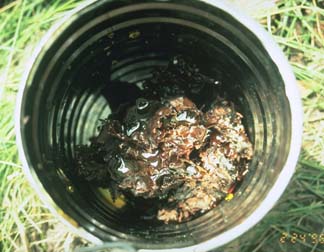egng ubanyj
egng alko
mayi wi'a |
in Uw Oykangand
in Uw Olkola
in Pakanh |

Sugarbag, near Oriners Station, February 1996
|
Sugarbag is the honey of wild Australian stingless bees (Trigona spp., belonging to the family Apidae). The bees are called sugarbag bees.
The words above are used as the generic for any sugarbag and sugarbag bee species in each language.
There were few sweet foods available to Aboriginal people in traditional times and so sugarbag was highly prized. |
egng ayogol or egng oyogol
egng akamar
mayi wama |
in Uw Oykangand and Uw Olkola
in Uw Olkola
in Pakanh |

Sugarbag wax ball, Kowanyama Land and Natural Resources Management Office, March 1996
|
The wax inside a sugarbag is saturated with honey. It needs to be processed by chewing and squeezing it to remove the honey. It may then be used much as other traditional waxes, to fasten together the parts of various implements.
Sugarbag wax is very important in traditional material culture. Its uses include the following:
Sugarbag wax is softened by heating it over a fire or by chewing it. It may then be applied in the desired way, smoothed out and/or flattened with a resin pallet, and left to harden.
When being stored it is normally rolled into a ball, as shown in the accompanying image. |




